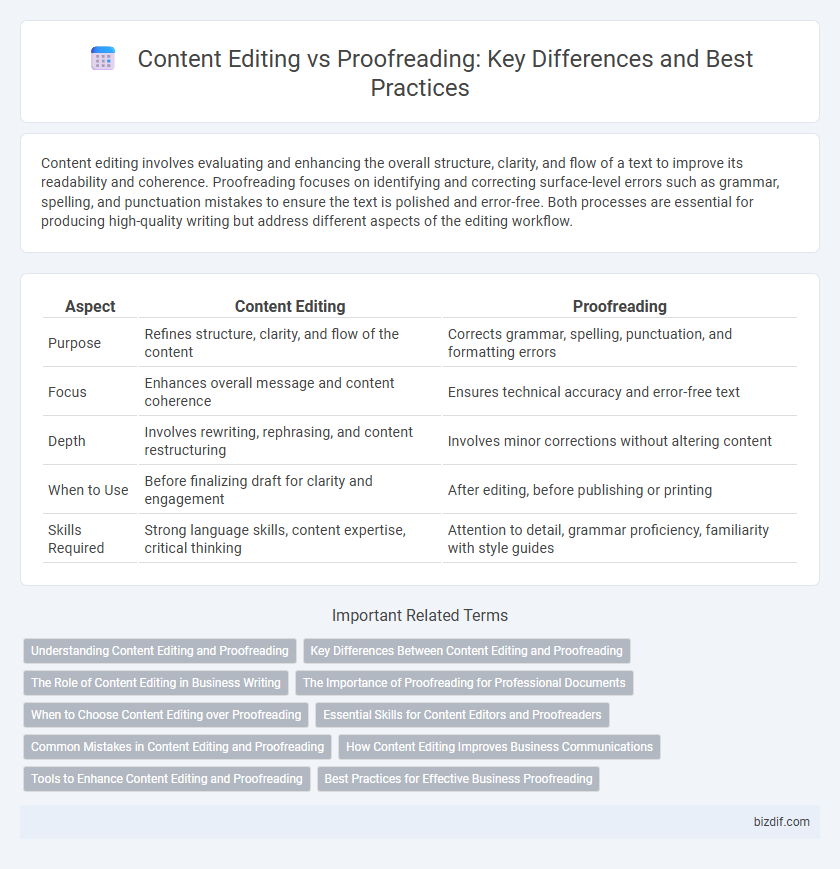Content editing involves evaluating and enhancing the overall structure, clarity, and flow of a text to improve its readability and coherence. Proofreading focuses on identifying and correcting surface-level errors such as grammar, spelling, and punctuation mistakes to ensure the text is polished and error-free. Both processes are essential for producing high-quality writing but address different aspects of the editing workflow.
Table of Comparison
| Aspect | Content Editing | Proofreading |
|---|---|---|
| Purpose | Refines structure, clarity, and flow of the content | Corrects grammar, spelling, punctuation, and formatting errors |
| Focus | Enhances overall message and content coherence | Ensures technical accuracy and error-free text |
| Depth | Involves rewriting, rephrasing, and content restructuring | Involves minor corrections without altering content |
| When to Use | Before finalizing draft for clarity and engagement | After editing, before publishing or printing |
| Skills Required | Strong language skills, content expertise, critical thinking | Attention to detail, grammar proficiency, familiarity with style guides |
Understanding Content Editing and Proofreading
Content editing involves evaluating and improving the overall structure, clarity, and flow of a text to enhance its readability and coherence. Proofreading focuses on identifying and correcting surface errors such as grammar, punctuation, spelling, and formatting inconsistencies. Understanding the distinct purposes of content editing and proofreading ensures that written material is both well-organized and error-free.
Key Differences Between Content Editing and Proofreading
Content editing focuses on improving the overall structure, clarity, and flow of a document, targeting elements such as organization, tone, and style to enhance reader engagement. Proofreading primarily addresses surface-level errors including grammar, punctuation, spelling, and formatting to ensure accuracy and consistency. The key difference lies in content editing's scope of revising substance and meaning, while proofreading serves as the final quality check before publication.
The Role of Content Editing in Business Writing
Content editing enhances business writing by refining structure, clarity, and tone to ensure the message aligns with target audience expectations and brand voice. It involves evaluating flow, consistency, and factual accuracy to improve overall communication effectiveness. This process helps businesses create persuasive, professional documents that drive engagement and achieve strategic objectives.
The Importance of Proofreading for Professional Documents
Proofreading is a critical step in ensuring professional documents are free of grammatical errors, typos, and formatting inconsistencies that can undermine credibility. Unlike content editing, which addresses overall structure and clarity, proofreading focuses on the fine details that enhance accuracy and polish. Meticulous proofreading preserves the document's professionalism and helps maintain the author's intended message.
When to Choose Content Editing over Proofreading
Content editing is essential when restructuring, enhancing clarity, or refining the overall flow and coherence of a text, especially for drafts or complex documents. Choosing content editing over proofreading guarantees that issues with argument strength, organization, and style are addressed before focusing on grammar and punctuation. Proofreading is suitable only after content editing is complete to ensure the final text is error-free and polished for publication.
Essential Skills for Content Editors and Proofreaders
Content editors excel in skills such as structural analysis, clarity enhancement, consistency checks, and tone adjustment to improve overall readability and coherence. Proofreaders specialize in detecting and correcting typographical errors, grammar mistakes, punctuation inaccuracies, and formatting inconsistencies. Mastery of language rules, attention to detail, and an understanding of the target audience are essential for both roles to ensure polished and professional final content.
Common Mistakes in Content Editing and Proofreading
Common mistakes in content editing include inconsistent tone, unclear structure, and overlooked factual inaccuracies that compromise the overall message. Proofreading errors often involve missing typographical errors, grammatical slips, and formatting inconsistencies that affect readability. Both processes require meticulous attention to detail to ensure polished, error-free content aligned with the intended purpose.
How Content Editing Improves Business Communications
Content editing enhances business communications by refining clarity, tone, and structure to align with the target audience's needs, thereby increasing engagement and trust. It ensures messages are coherent and persuasive, supporting brand consistency and professional image across all platforms. Effective content editing reduces misunderstandings and improves the overall impact of corporate communications, driving better customer relationships and business outcomes.
Tools to Enhance Content Editing and Proofreading
Content editing tools like Grammarly and Hemingway Editor enhance clarity, structure, and style by analyzing grammar, readability, and tone, while proofreading tools such as ProWritingAid and Ginger focus on identifying typos, spelling errors, and punctuation mistakes. Integration of AI-powered platforms such as LanguageTool provides comprehensive checks that blend content editing nuances with meticulous proofreading accuracy. Utilizing these advanced tools significantly improves text quality, ensuring polished and error-free documents.
Best Practices for Effective Business Proofreading
Effective business proofreading requires a meticulous review of grammar, punctuation, and spelling to ensure error-free content that enhances professionalism and credibility. Content editing focuses on improving clarity, tone, and structure, while proofreading targets surface-level mistakes that can undermine the message's impact. Utilizing style guides and multiple review stages ensures consistency and precision, crucial for maintaining brand integrity in business communications.
Content Editing vs Proofreading Infographic

 bizdif.com
bizdif.com